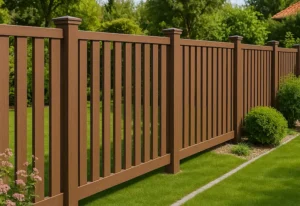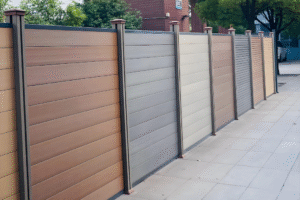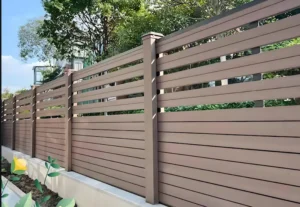WPC fence is also known as Wood-Plastic Composite fencing, is widely used in modern landscaping due to its durability and sustainability. (Learn more about what WPC fence is here.)
One of the key advantages of WPC fencing is its versatile design options. Among them, three types of WPC fences are commonly used:
- Full Privacy WPC Fences
- Semi-Open WPC Fences
- Spaced WPC Fences
Each type serves different needs and suits different outdoor environments. In this article, we’ll explore their features, ideal applications, and benefits in detail.
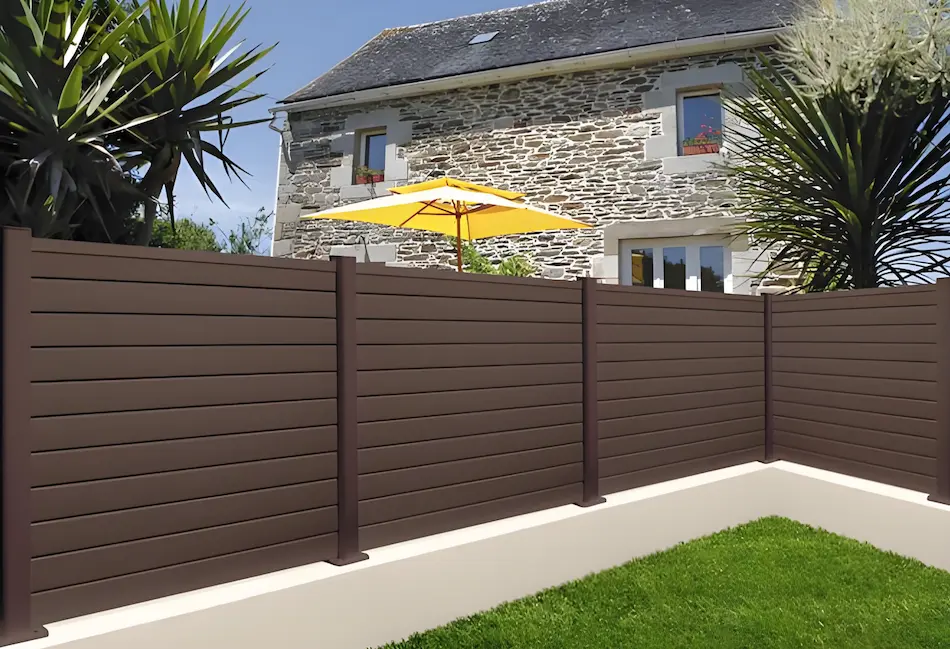
1st types of WPC fences-Full Privacy WPC Fences
Design and Structure
Full privacy fences are built using solid WPC boards placed closely together, with no visible gaps between panels. These panels are fixed using concealed connectors for a sleek, unified look.
The result is a fence that forms a complete visual barrier, offering maximum seclusion and protection from outside elements.
Ideal Applications
This design is best suited for:
- Residential yards
- Private patios or gardens
- Areas close to roads or walkways
- Industrial zones requiring secure boundaries
For homeowners, this fence ensures full privacy during family gatherings, outdoor dining, or relaxation. In commercial settings, it helps control access and secure operations.
Key Benefits
- Total Privacy: Blocks all outside views for peace of mind.
- Noise Reduction: Helps create a quiet outdoor environment by buffering sound.
- Wind and Dust Protection: Shields against harsh weather and debris.
- Strong and Durable: Withstands impact, bending, and weather damage.
Thanks to its solid form, a full privacy WPC fence also adds a sense of structure and permanence to your property.
For homeowners who want better durability and aesthetics compared to plastic fencing, WPC is often the preferred choice. (See how WPC fences compares to PVC fences here.)
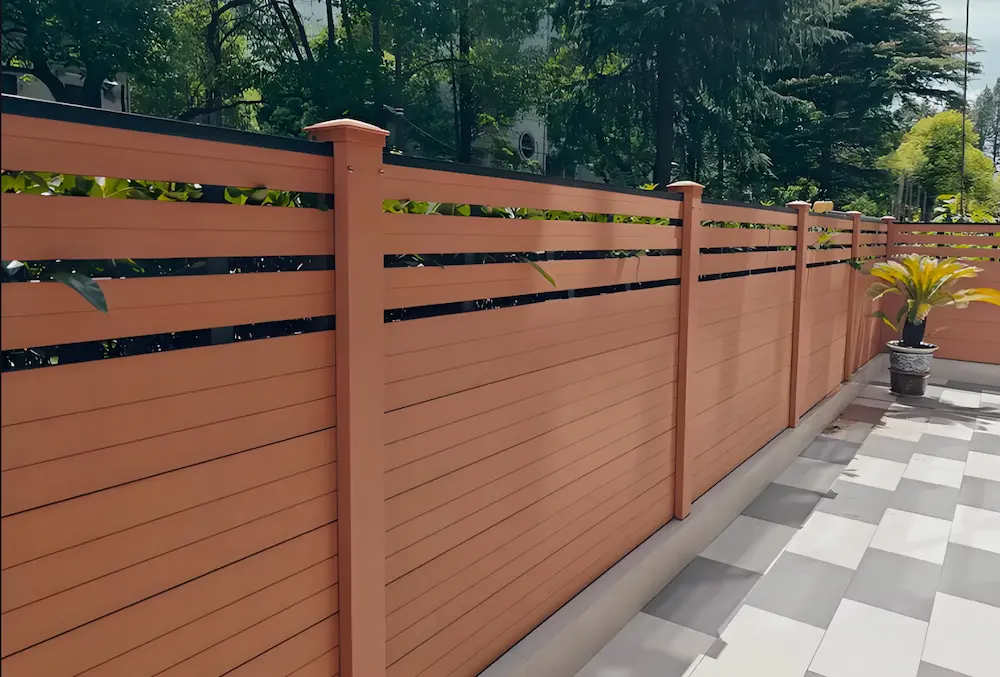
2nd types of WPC fences-Semi-Open WPC Fences
Design and Structure
Semi-open fences combine the visual elegance of open designs with partial privacy. These fences include decorative gaps or cutouts between slats—usually narrow enough to provide coverage but wide enough to let in air and light.
Common styles include:
- Narrow vertical gaps between panels
- Decorative laser-cut patterns
- Horizontal slat designs with limited spacing
Ideal Applications
This style is perfect for:
- Residential gardens
- Community parks
- Apartment complexes
- Villas and private courtyards
In these settings, a semi-open fence allows the landscape to breathe. It creates a sense of openness without fully exposing the space.
Key Benefits
- Balanced Privacy: Offers partial coverage while keeping views partially open.
- Improved Ventilation: Prevents heat buildup by letting air circulate.
- Enhanced Aesthetics: Adds a modern, artistic touch to the fence line.
- Filtered Light: Allows natural sunlight to reach plants and seating areas.
A semi-open WPC fence is ideal for those who value both functionality and visual appeal in their outdoor space.
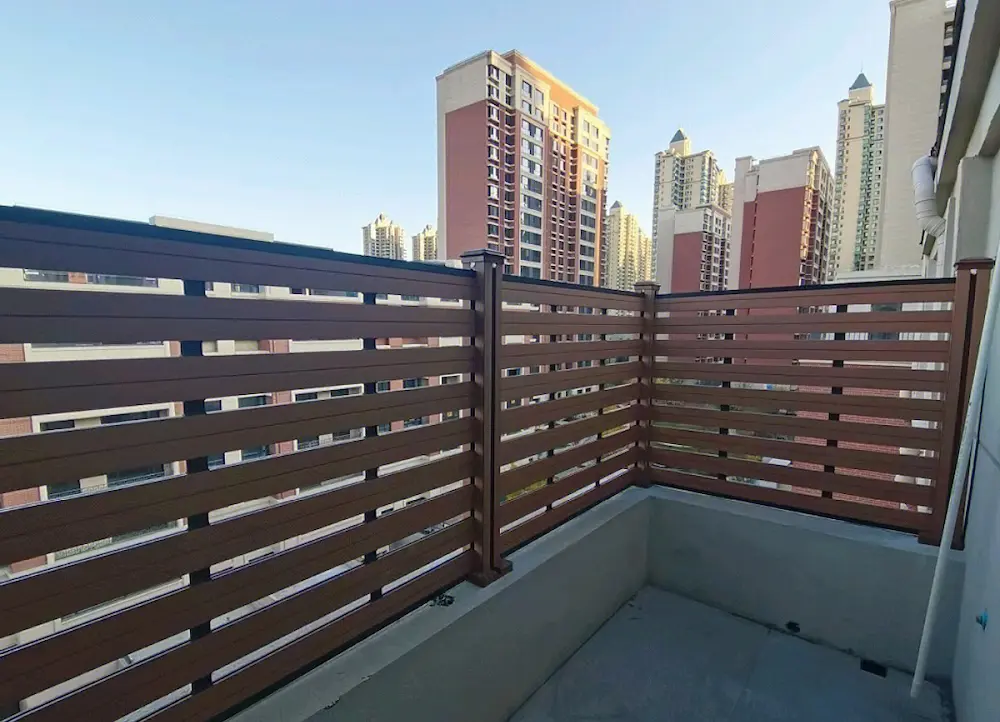
3rd types of WPC fences-Spaced WPC Fences
Design and Structure
Spaced fences, also called open-style or picket-style WPC fences, use evenly spaced slats arranged vertically or horizontally. The spacing typically ranges from 10 to 30 centimeters, depending on design goals.
This type emphasizes openness and visual continuity with the surrounding landscape.
Ideal Applications
Spaced WPC fences are commonly used in:
- Scenic walkways
- Botanical gardens
- Public plazas
- Schoolyards and campuses
- Open backyard borders
Because they don’t obstruct the view, they are perfect for defining boundaries without creating a sense of enclosure.
Key Benefits
- Great Visibility: Keeps sightlines open for scenic or surveillance purposes.
- Wind Resistance: Reduces wind pressure on the panels, enhancing stability.
- Air Circulation: Promotes airflow to prevent heat buildup.
- Lightweight and Affordable: Uses less material, making it easier to install and more budget-friendly.
A spaced WPC fence is a great choice for blending structure with openness, especially in areas where natural visibility and airflow are desired.
How to Choose the Right WPC Fence Style
How to choose these three types of wpc fences? Choosing the best WPC fence design depends on your priorities. Here’s a quick guide:
- Need complete privacy? Go for a Full Privacy Fence.
- Prefer style with moderate coverage? Choose a Semi-Open Fence.
- Want visibility and airiness? Opt for a Spaced Fence.
Also consider factors like:
- Your property’s wind conditions
- Aesthetic preferences (modern vs. traditional look)
- Functional needs (security, pet safety, zoning)
Many manufacturers also offer customizable options. You can select the color, grain texture, slat width, and spacing to match your landscape.
Why Choose WPC Fence?
No matter the design, WPC fences offer key advantages over traditional wood or metal:
- Waterproof and Weather-Resistant
- Anti-Termite and Rot-Free
- Eco-Friendly and Made from Recycled Materials
- Low Maintenance – no need to paint, seal, or treat regularly
Whether you’re a homeowner, developer, or landscape designer, WPC fence delivers long-term performance with modern aesthetics. Want to know more about wpc fencing, you can read this 7 Advantages of WPC Fencing.
Conclusion
WPC fence is more than just a boundary—it’s an extension of your outdoor living space. By choosing the right fence type—full privacy, semi-open, or spaced—you can achieve the perfect balance of security, ventilation, design, and privacy.
Take the time to assess your needs and match them with the right WPC fence style. The result will be a beautiful, functional, and durable outdoor solution that stands the test of time.

